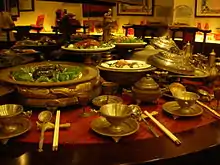Manchu–Han Imperial Feast
The term Manchu–Han Imperial Feast (simplified Chinese: 满汉全席; traditional Chinese: 滿漢全席; pinyin: Mǎnhàn quánxí, also Comprehensive Manchu–Han Banquet[1]) refers to a grand banquet held sometime[1] in the Qing dynasty of China (1644–1911). One of the grandest meals ever documented in Chinese culinary history, the banquet reportedly consisted of 108 dishes served in six meals over the course of three days. The dishes themselves involved exotic ingredients and a variety of cooking techniques from every part of Imperial China.[2]
| Manchu–Han Imperial Feast | |||||||||||||||||||||||||||
|---|---|---|---|---|---|---|---|---|---|---|---|---|---|---|---|---|---|---|---|---|---|---|---|---|---|---|---|
 Manchu Han Imperial Feast displayed at Tao Heung Museum of Food Culture | |||||||||||||||||||||||||||
| Chinese name | |||||||||||||||||||||||||||
| Traditional Chinese | 滿漢全席 | ||||||||||||||||||||||||||
| Simplified Chinese | 满汉全席 | ||||||||||||||||||||||||||
| |||||||||||||||||||||||||||
| Vietnamese name | |||||||||||||||||||||||||||
| Vietnamese alphabet | Mãn Hán toàn tịch | ||||||||||||||||||||||||||
| Korean name | |||||||||||||||||||||||||||
| Hangul | 만한전석 | ||||||||||||||||||||||||||
| Hanja | 滿漢全席 | ||||||||||||||||||||||||||
| |||||||||||||||||||||||||||
| Japanese name | |||||||||||||||||||||||||||
| Kanji | 満漢全席 | ||||||||||||||||||||||||||
| Kana | まんかんぜんせき | ||||||||||||||||||||||||||
| |||||||||||||||||||||||||||
History
Qing dynasty
When the Manchus conquered China and founded the Qing dynasty, the Manchu and Han Chinese peoples struggled for power. The Kangxi Emperor wanted to resolve the disputes, so he held a banquet during his 66th birthday celebrations. The banquet consisted of Manchu and Han dishes, with officials from both ethnic groups attending the banquet together. After the Wuchang Uprising, common people learned about the imperial banquet. The original meal was served in the Forbidden City in Beijing.[2]
Preparation
The meal comprised six banquets over three days with over 300 dishes. Altogether there are said to have been 196 main dishes and 124 snack dishes, for a total of 320 dishes sampled over three days. Depending on how the dishes are counted with the samples, at the absolute minimum there were 108 dishes.[2] The feast was divided into inner-palace and outer-palace banquets; only the imperial family and meritorious officials, including Han officials above the second rank, were invited into the inner-palace banquets. A book from the reign of the Qianlong Emperor (1735–1796) gives a detailed description of the feast and the dishes and ingredients.
The meal
It is said that there were "Thirty-Two Delicacies," referring to the more exotic ingredients used for the banquet. The "Eight Mountain Delicacies" includes such dishes as camel's hump, bear's paws, monkey's brains, ape's lips, leopard fetuses, rhinoceros tails, and deer tendons. The "Eight Land Delicacies" includes several precious fowls and mushrooms, and the "Eight Sea Delicacies" includes dried sea cucumbers, shark's fin, bird's nest and others.
Some of the individual names of the dishes within:
- Snowy Palm - bear claw with sturgeon[2]
- Golden Eyes and Burning Brain - bean curd simmered in chicken, duck and cuckoo brains
- Monkey King and Shark - goat brain
- Monkey brain
- Egg tart
- Wensi Tofu
- Dezhou braised chicken
- Peking duck
- Shark fin soup
- Edible bird's nest
- Dried Sea Cucumbers
- Ye wei
Utensils
The utensils, like the food, were lavish; the majority of utensils were finely crafted bronzeware, and porcelainware in the shape of many animals were designed with mechanisms for keeping the dishes warm throughout the meal. In general the Manchu dishes were first sampled, followed by the Han dishes.
In popular culture
The imperial meal was re-enacted in the movie The Chinese Feast and the television drama Happy Ever After. It is also featured in the anime Cooking Master Boy and the television series My Fair Princess, as well as in chapters 106 and 142 of the manga Medaka Box.
In modern times, the Chinese term "Manhan Quanxi" can be used as an idiomatic expression to represent any feast of significant proportions. As an example, various media outlets may refer to a dinner gala as "Manhan Quanxi", while in China there are also numerous cooking competitions which make use of the aforementioned name,[3] while not specifically referring to the original meaning of the imperial feast. The name is also used extensively in product names in the food industry, such usage evident as brands of sauces and instant noodles by various companies.
An abridged version of the Cantonese version of the imperial meal was depicted in Mister Ajikko, where the dessert: Almond Tofu dessert is used as a contest against the expert in the dish: A corrupt monk in the Cuisine Temple.[4]
An inspiration of the imperial meal was re-enacted in Kung Fu Panda Holiday.
A fictional Japanese version of the imperial meal was depicted in The Last Recipe.[5]
In the anime Kore wa Zombi Desu ka? (English: Is This a Zombie?) the mute character Eucliwood Hellscythe, who communicates by writing messages, demands that the main character make her dinner; then follows up this demand by demanding a "Manchu Imperial Feast."
Replicas
There have been attempts since 1720 to replicate the original Manhan Quanxi. In the late 1980s a certain replica meal was estimated to cost over one million Japanese yen.[4] Many of the animals used in the meal are endangered species today.
See also
Notes
- Isaac Yue (2018). "The Comprehensive Manchu–Han Banquet: History, Myth, and Development". Ming Qing Yanjiu. Brill. 22 (1): 93–111. doi:10.1163/24684791-12340022. Retrieved 2020-01-25.
- Michael Hoover; Lisa Odham Stokes (1999). City on Fire: Hong Kong Cinema. Verso. ISBN 1-85984-203-8.
- 红厨帽快车-新闻中心 Archived 2011-07-23 at the Wayback Machine
- Episode 57 of Mr. Ajikko (Japanese with Chinese subtitles)
- "The Last Recipe: Kirin no shita no kioku (2017)". IMDb. 3 Nov 2017. Retrieved 31 May 2018.